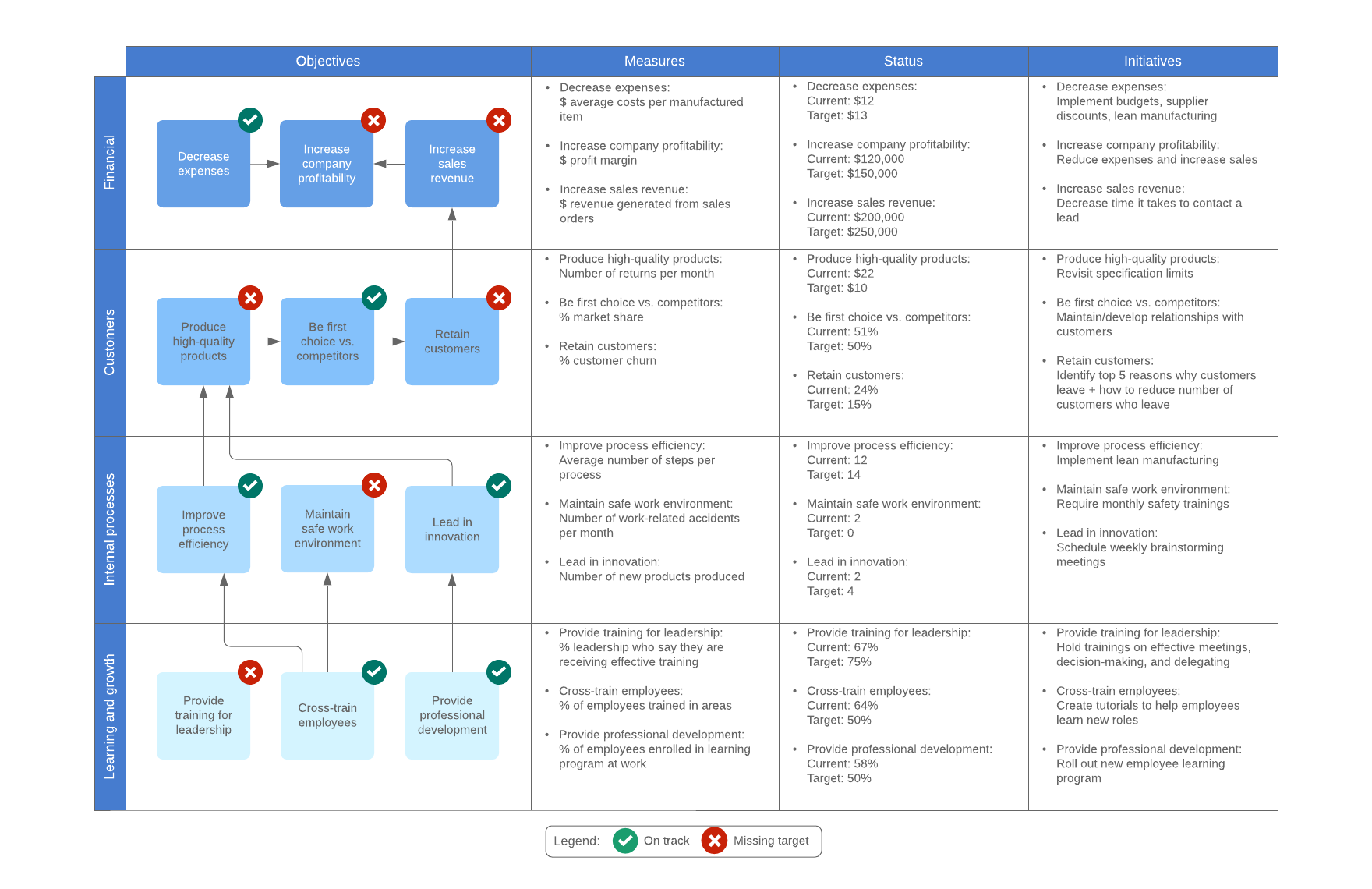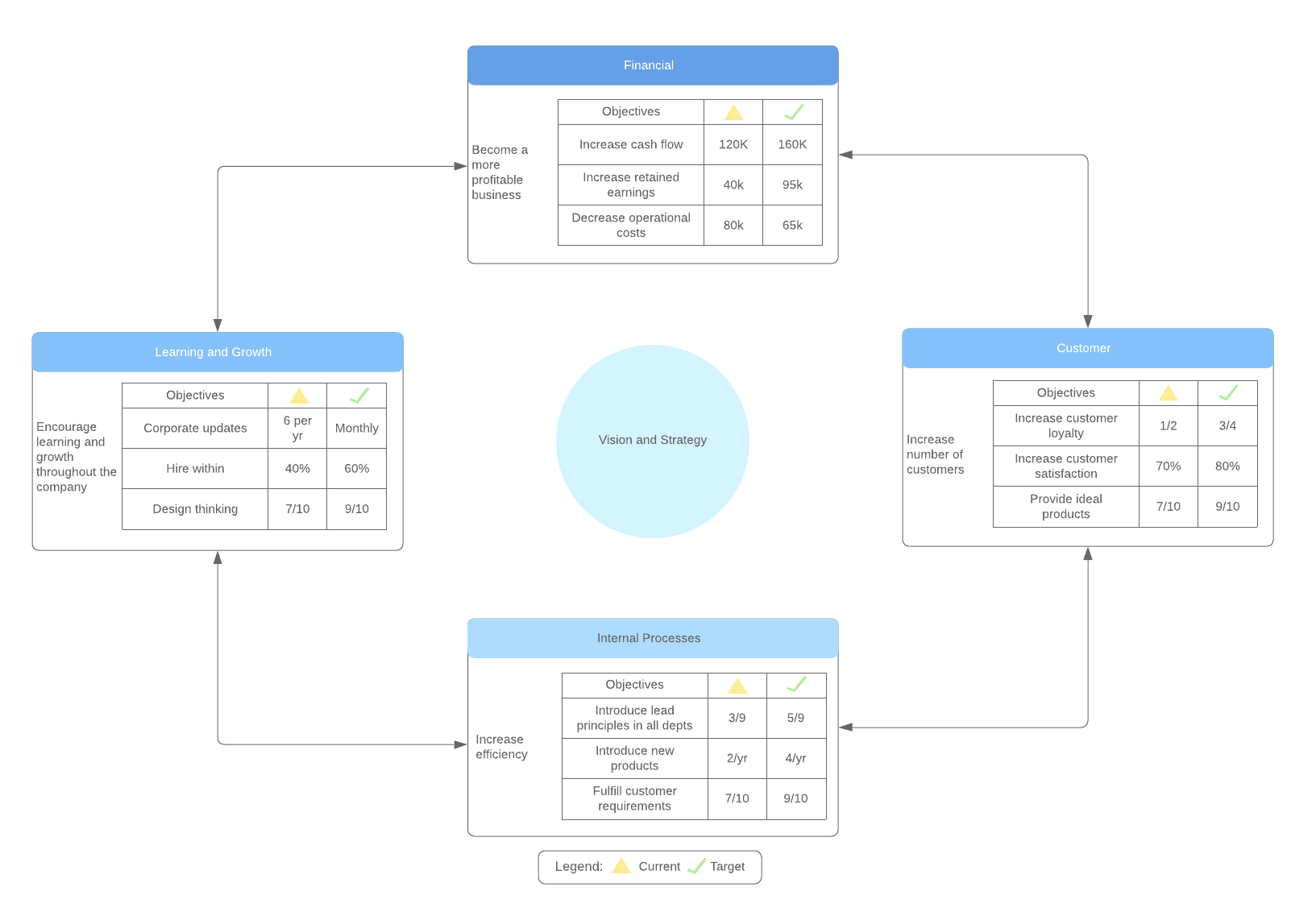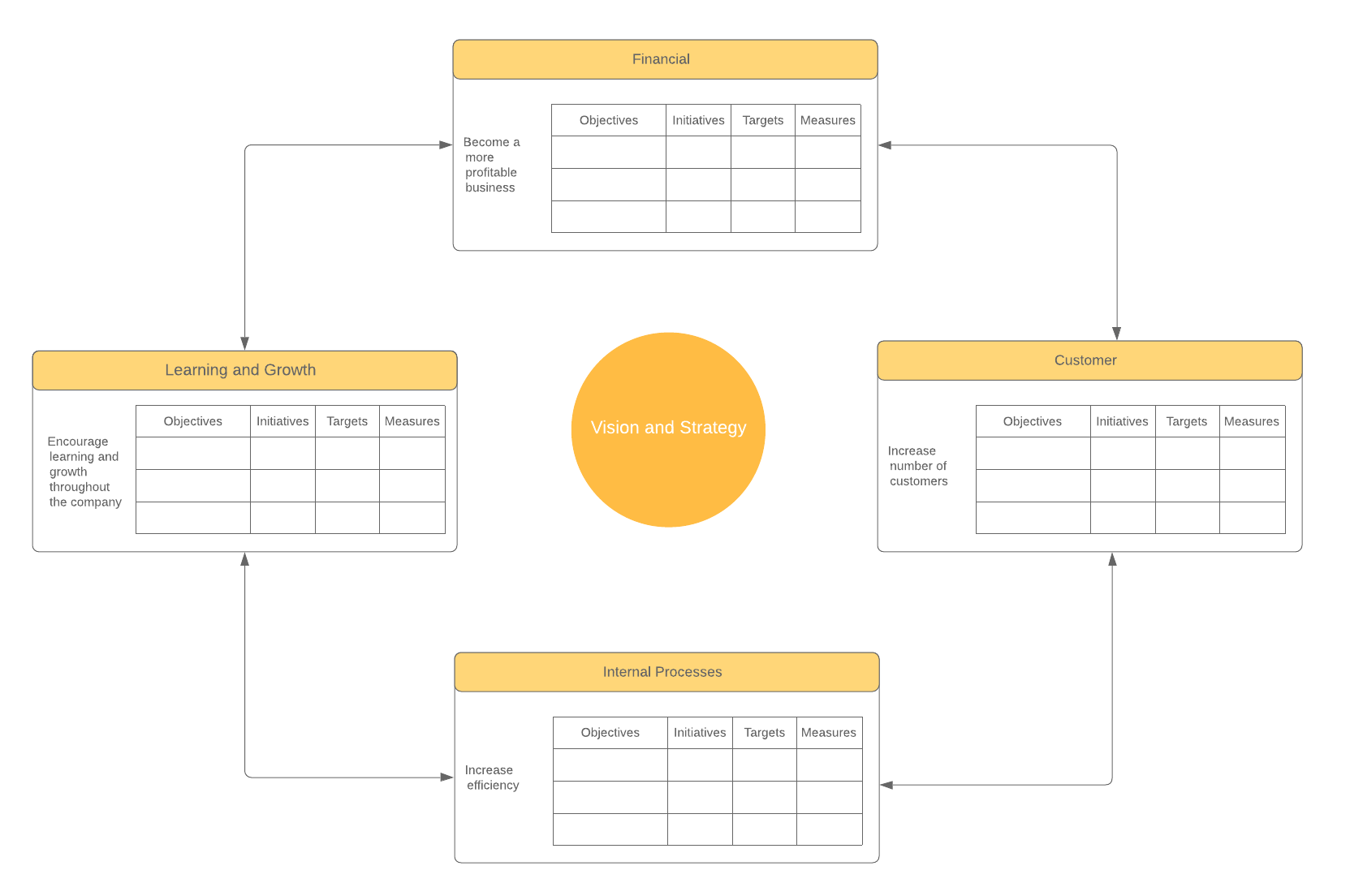Strategically Aligning Family and Business Systems Using the Balanced Scorecard
How to Create a Balanced Scorecard to Achieve Strategic Goals
Reading time: about seven min
Posted past: Lucid Content Team
The balanced scorecard (BSC) was developed in the 1990s and chop-chop rose to popularity amongst organizations large and small. The revolutionary management tool shifted the traditional focus on revenue and financial health to a more holistic and comprehensive understanding of a business concern's performance.
Today, 70% of businesses utilize a balanced scorecard at least partially to manage their strategic goals. Pretty impressive for a system that is less than xxx years old.
Let's have a wait at how a counterbalanced scorecard works and how you tin can utilize Lucidchart to make your ain.

What is a counterbalanced scorecard?
The balanced scorecard is a management organisation originally developed by Robert Kaplan and David Norton to help organizations achieve their business concern objectives and execute primal strategies.
In the by, organizations tended to focus on primarily fiscal metrics and objectives to manage their business organization and develop strategies. While finances and revenue play an important role in the wellness and operation of whatsoever business, this focus gives an incomplete picture of success (or failure).
The balanced scorecard aims to remainder the strategic goals and overall vision of an organization by identifying, measuring, and managing iv main business organization perspectives:
- Client
- Financial
- Internal business processes
- Learning and growth
Inside these four pillars, leaders outline their strategic objectives for each business concern perspective and link those performance measures with a strategy map. The strategy map shows how each objective relates to one another so leaders can become a loftier-level view of their organization's strategy at a glance.
Keep in listen that, while performance measurement is a component of the balanced scorecard, the BSC is starting time and foremost a direction system.
By combining the four principal business perspectives, the BSC helps businesses and their leaders make better-informed decisions and lead with confidence.
Understanding the four perspectives
The counterbalanced scorecard evaluates the health of your organization by considering four main perspectives. Each perspective focuses on a different function of the business to give leaders a comprehensive and nuanced understanding of the company'south performance.
Learning and growth
This perspective is also called "organizational capacity." It looks at organizational performance through the lens of human being capital letter, culture, engineering, and infrastructure.
For instance, are your employees using your technology stack to execute tasks and manage processes? Does your organization provide adequate training and resource? What steps are y'all taking to remain competitive?
The learning and growth perspective considers how well information and knowledge are captured and implemented by employees to create a competitive reward.
Internal business organization processes
The next perspective focuses on how well your internal processes are operating.
Are in that location gaps, delays, or bottlenecks in the pipeline that need to be addressed? How can you streamline your processes for greater efficiency and effectiveness? How quickly can your organization suit to changing concern needs or conditions?
Customer
The customer perspective asks "What is important to our customers and stakeholders?" This perspective focuses on finding new customers, building brand recognition and trust, and increasing client satisfaction.
In other words, how well are you serving your customers and the stakeholders your organization was designed to serve?
Financial
The final piece of the puzzle is the system'due south financial state. Yep, this is the perspective too frequently over-emphasized in the past.
Just, though finances are lagging indicators of past decisions, they are however an important part of whatsoever organization'due south health and key to understanding overall performance and creating strategies for the future.

Benefits of using a counterbalanced scorecard
Every bit its name suggests, one of the most pregnant advantages of using a balanced scorecard is creating a balanced understanding of your organization'due south functioning. Only that's by no ways the only benefit.
Apply a balanced scorecard to reap the following benefits and competitive advantages.
Better strategic planning
The balanced scorecard helps business leaders speedily dribble the most important priorities for each arm of their organization and align those strategies for optimal performance.
The balanced scorecard is particularly useful for large organizations who could easily lose sight of one or more perspectives. By bringing together 4 principal perspectives, senior leadership can create clear strategies that align across the system.
Improved project alignment
With meliorate strategic planning comes improved outcomes for projects and initiatives across the organization. When leaders define the strategic priorities at each level, departments and teams can so ensure their projects align appropriately with the overarching goals of the business.
For example, when employees understand the broader organizational objectives, they can set personal and squad goals more effectively and plan and prioritize projects that align with the business strategy.
Effective performance measurement
Though the balanced scorecard is a management system first, it is likewise a powerful tool for measuring performance and improving operation outcomes.
A well-defined balanced scorecard creates a structured framework for measuring performance and helps organizations communicate operation conspicuously. Past combining strategic goals with concrete performance metrics, the BSC helps organizations and teams execute the depression-level tactical efforts needed to reach their loftier-level goals.

Building your own balanced scorecard
In that location are multiple ways to create and visualize your balanced scorecard. Consider starting with a basic balanced scorecard template or build your own from scratch. Customize information technology to your needs and do what works best for you.
Once y'all have your balanced scorecard template ready, you tin can beginning filling in the blanks.
1. Place your strategic objectives
The first footstep to building your balanced scorecard is to identify your strategic objectives for each business organization perspective: learning and growth, internal business processes, customer, and fiscal.
Typically, each perspective will have multiple strategic goals (at least two or three) to focus on. Examples might include:
- Cross-grooming employees
- Leading in innovation
- Retaining customers
- Improving process efficiency
- Increasing sales acquirement
Remember to keep goals specific only high-level. Nosotros'll drill downward into more specific measures of operation for each objective afterward.
2. Create a strategy map
Next, you volition create a strategy map. A strategy map is a diagram that shows the connections or relationships between your strategic objectives.
This is a useful tool for apace communicating your organizational strategy and demonstrating how each section, team, or private contributes to the broader goals of the company. An easy fashion to show these relationships on your diagram is with directional arrows to show the strategic path and connection between each goal.
3. Outline the measures
The last step is to outline the specific metrics you volition use to mensurate success for each strategic goal. For instance, if i of your goals for your internal business concern processes is to lead in innovation, you could measure success by the number of new products produced.
The key hither is to list out the measures for each objective and and then outline the electric current state metric and the future goal. Then, if y'all're measuring the number of products you produce, you would write the electric current production number along with the target number.
Together, these outlined measures will help yous quickly see how you lot are performing on any given objective and which areas may need additional support.

Using Lucidchart to create your own balanced scorecard
Lucidchart is a diagramming solution that helps executive leaders, managers, and employees create powerful visuals for their businesses. Use Lucidchart to create a custom balanced scorecard that elegantly communicates your strategic goals and keeps anybody on track to meet performance benchmarks.
Whether you customize a pre-made template or beginning your own diagram from scratch, you can create cute visualizations at the click of a button in Lucidchart.
Information linking lets you lot import data direct to your document so you can get real-time updates and meet all your information at a glance. Plus, conditional formatting lets you build visual cues correct into the design so you can quickly see progress on goals or identify metrics that need the well-nigh attending.
The dazzler of the balanced scorecard is in its simplicity and flexibility. With the help of Lucidchart, you tin apace construction a strategic direction arrangement that works across the entire organization.
Source: https://www.lucidchart.com/blog/how-to-create-a-balanced-scorecard
0 Response to "Strategically Aligning Family and Business Systems Using the Balanced Scorecard"
Post a Comment